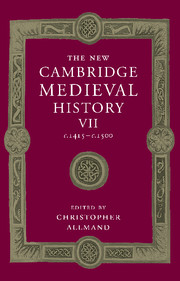Book contents
- Frontmatter
- PART I GOVERNMENT
- PART II ECONOMIC AND SOCIAL DEVELOPMENTS
- PART III SPIRITUAL, CULTURAL AND ARTISTIC LIFE
- PART IV THE DEVELOPMENT OF EUROPEAN STATES
- 17 Germany and the Empire
- 18 Hus, the Hussites and Bohemia
- 19 France
- 20 Burgundy
- 21 England
- 22 The Celtic world
- 23 Italy
- 24 The Iberian peninsula
- 25 The Swiss Confederation
- 26 The States of Scandinavia, c. 1390– c. 1536
- 27 Hungary: Crown and Estates
- 28 The Kingdom of Poland and the Grand Duchy of Lithuania, 1370–1506
- 29 Russia
- 30 Byzantium: The Roman Orthodox World, 1393–1492
- 31 The Latin East
- 32 The Ottoman World
- 33 Conclusion
- Appendix Genealogical Tables
- Primary Sources and Secondary Works Arranged by Chapter
- Index
- Frontispiece
- Plate section
- Map 1 European towns in the late Middle Ages
- Map 2 European commerce and trade
- Map 4 Winds and currents facilitating the discoveries
- Map 5 The universities o f Europe in 1400 and 1500
- Map 6 Germany and the Empire
- Map 20 The Roman Orthodox and Ottoman worlds in the fifteenth century
- References
25 - The Swiss Confederation
from PART IV - THE DEVELOPMENT OF EUROPEAN STATES
Published online by Cambridge University Press: 28 March 2008
- Frontmatter
- PART I GOVERNMENT
- PART II ECONOMIC AND SOCIAL DEVELOPMENTS
- PART III SPIRITUAL, CULTURAL AND ARTISTIC LIFE
- PART IV THE DEVELOPMENT OF EUROPEAN STATES
- 17 Germany and the Empire
- 18 Hus, the Hussites and Bohemia
- 19 France
- 20 Burgundy
- 21 England
- 22 The Celtic world
- 23 Italy
- 24 The Iberian peninsula
- 25 The Swiss Confederation
- 26 The States of Scandinavia, c. 1390– c. 1536
- 27 Hungary: Crown and Estates
- 28 The Kingdom of Poland and the Grand Duchy of Lithuania, 1370–1506
- 29 Russia
- 30 Byzantium: The Roman Orthodox World, 1393–1492
- 31 The Latin East
- 32 The Ottoman World
- 33 Conclusion
- Appendix Genealogical Tables
- Primary Sources and Secondary Works Arranged by Chapter
- Index
- Frontispiece
- Plate section
- Map 1 European towns in the late Middle Ages
- Map 2 European commerce and trade
- Map 4 Winds and currents facilitating the discoveries
- Map 5 The universities o f Europe in 1400 and 1500
- Map 6 Germany and the Empire
- Map 20 The Roman Orthodox and Ottoman worlds in the fifteenth century
- References
Summary
introduction
The system of alliances among imperial provinces and cities in the area between the Alps, the Jura mountains and the Rhine, known as the Swiss Confederation (Schweizerische Eidgenossenschaft), emerged about the year 1500 as a distinct political unit within the German Empire. The Confederation as a whole occupied no clearly defined territory. However, by 1500, the northern limits of its sphere of influence ran more or less along the Rhine as far as Lake Constance. In the east, its frontier with Graubünden was unclear; the west of what is now Switzerland was largely under the dominion of Savoy; south of the Alps, the hegemony of Milan persisted until shortly before 1500. Within the Confederation of cantons, or Orte (the traditional name for members enjoying full rights), with their widely differing structures and identities, each guarded its freedom of manoeuvre in both domestic and foreign politics, but, by 1500, did have a visible political cohesion.
The Confederation, at first just one of the numerous systems of alliances existing within the German Empire, had not succeeded in giving itself a more stable framework until after 1350, and then only hesitantly. Alongside the free imperial cities of Berne and Zurich, the centres of political power within the federation, the cities of Lucerne and Zug appear as early as the fourteenth century as full members of the Confederation. Fribourg and Solothurn already belonged to this circle well before the end of the fifteenth century, when their membership, like that of Basle and Schaffhausen, became more binding. Among the rural communes, important members of the alliance were the valley communities and imperial districts in the alpine region of central Switzerland; other rural members were Glarus and the hinterland of Zug.
Keywords
- Type
- Chapter
- Information
- The New Cambridge Medieval History , pp. 645 - 670Publisher: Cambridge University PressPrint publication year: 1998
References
- 2
- Cited by

